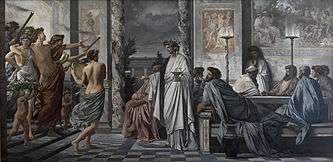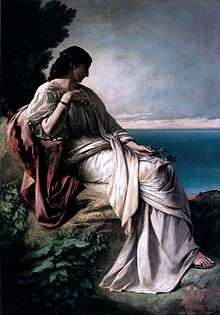Anselm Feuerbach
| Anselm Feuerbach | |
|---|---|
 Self-portrait (1873) | |
| Born |
Anselm Feuerbach 12 September 1829 Speyer |
| Died |
4 January 1880 (aged 50) Venice |
| Nationality | German |
| Known for | Painting |
| Movement | Neoclassicism |
Anselm Feuerbach (12 September 1829 – 4 January 1880) was a German painter. He was the leading classicist painter of the German 19th-century school.
Biography
Early life

Feuerbach was born at Speyer, the son of the well-known archaeologist Joseph Anselm Feuerbach and the grandson of the legal scholar Paul Johann Anselm Ritter von Feuerbach. The house of his birth is now a small museum.[1]
Between 1845 and 1848 he attended the Düsseldorf Academy, where he was taught by Johann Wilhelm Schirmer, Wilhelm von Schadow, and Carl Sohn. He went on to the Munich Academy, but in 1850, along with a number of other dissatisfied students, he moved to the academy at Antwerp, where he studied under Gustav Wappers. Feuerbach moved to Paris in 1851, where he was a pupil of Thomas Couture until 1854.[2] It was in Paris that he produced his first masterpiece, Hafiz at the Fountain (1852).[3]
In 1854, funded by Grand Duke Friedrich of Baden he visited Venice,[2] where he fell under the spell of the greatest school of colourists, several of his works demonstrating a close study of the Italian masters.[3] From there he continued to Florence and then to Rome. He remained in Rome until 1873, making brief visits back to Germany.[2] In 1861 he met Anna Risi (known as "Nanna"), who sat as his model for the next four years.[2]:270 In 1866 she was succeeded as his principal model by Lucia Brunacci, an innkeeper's wife who posed for his pictures of Medea.[2] In 1862 Feuerbach met Count Adolf Friedrich von Schack, who commissioned copies of Italian old masters from him. The count introduced him to Arnold Böcklin and Hans von Marées. The three artists became known as the Deutschrömer ("German Romans") because of their preference for Italian over German art.[2]
In 1873 Feuerbach moved to Vienna, having been appointed professor of history painting at the Academy.[2] Feuerbach developed a disagreement with architect Theophil Hansen over his ceiling mural The Fall of the Titans, painted for the Great Hall of the new Academy building on the Ringstrasse. While in the Vienna he came to know Johannes Brahms.
Last years

In 1877 he resigned from his post at the Vienna Academy and moved to Venice, where he died in 1880.[2] Brahms composed Nänie, a piece for chorus and orchestra, in his memory.
Following the death of his step-mother, Henriette, to whom he had always been close, and who had always done much to promote his career, a book was compiled entitled Ein Vermächtnis ("A Testament") from his letters and autobiographical notes. It proved enormously successful and greatly enhanced his posthumous reputation.[4]
According to the 1911 Encyclopædia Britannica:
He was steeped in classic knowledge, and his figure compositions have the statuesque dignity and simplicity of Greek art. He was the first to realize the danger arising from contempt of technique, that mastery of craftsmanship was needed to express even the loftiest ideas, and that an ill-drawn coloured cartoon can never be the supreme achievement in art.[3]
His works are hoysed at leading public galleries in Germany. Stuttgart has the second version of Iphigenia; Karlsruhe, the Dante at Ravenna; Munich, the Medea; and Berlin, The Concert, his last important painting. Other major works include The Battle of the Amazons, Pietà, The Symposium of Plato, Orpheus and Eurydice and Ariosto in the Park of Ferrara.[3]
See also
Notes
References
-
 Chisholm, Hugh, ed. (1911). "Feuerbach, Anselm". Encyclopædia Britannica (11th ed.). Cambridge University Press.
Chisholm, Hugh, ed. (1911). "Feuerbach, Anselm". Encyclopædia Britannica (11th ed.). Cambridge University Press. -
 Rines, George Edwin, ed. (1920). "Feuerbach, Anselm". Encyclopedia Americana.
Rines, George Edwin, ed. (1920). "Feuerbach, Anselm". Encyclopedia Americana.
External links
| Wikimedia Commons has media related to Anselm Feuerbach. |
- Links to works
- German masters of the nineteenth century: paintings and drawings from the Federal Republic of Germany, a full text exhibition catalog from The Metropolitan Museum of Art, which contains material on Anselm Feuerbach (no. 25-28)